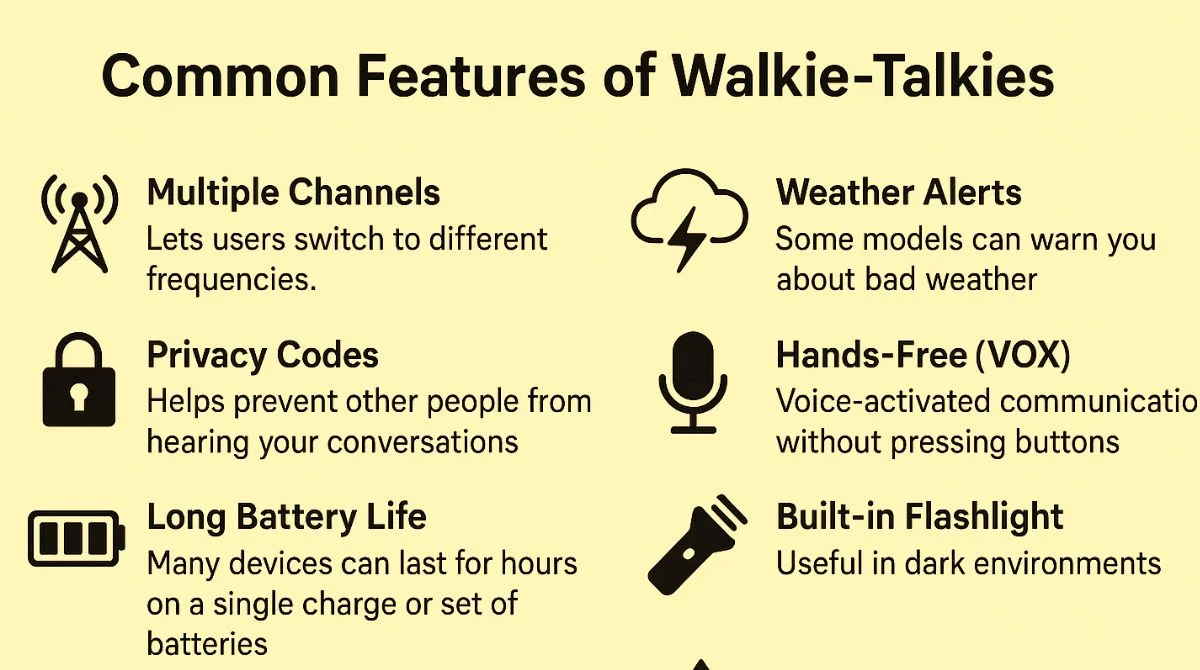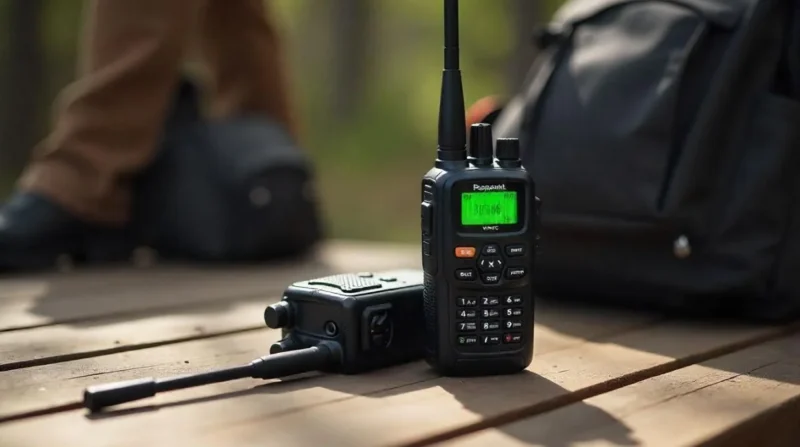Table of Contents
What Is a Walkie-Talkie?
A walkie-talkie is a two-way radio. That means it lets people talk and listen using radio waves. It’s kind of like a phone, but you don’t need a phone line or the internet. Walkie-talkies work well when you are close to the other person, usually within a few miles.
These radios are small enough to carry in your hand or pocket. That’s why they’re called “walkie-talkies,” you walk and talk at the same time.
Brief History
Walkie-talkies were first developed during World War II to enable soldiers to stay in touch without relying on wires or phones. These early devices were large and heavy, but they helped save lives by allowing quick and direct communication. Over time, technology improved. Walkie-talkies became smaller, lighter, and easier to use. Today, you can find models that fit in your pocket, as well as ones that work over long distances.
How Do Walkie-Talkies Work?
Walkie-talkies are simple, portable communication devices that use radio waves to send and receive voice messages. They’re commonly used by kids, outdoor adventurers, security teams, and event organizers because they don’t require cell service or internet.
Here’s how they work simply and clearly:
- Microphone: You talk into it. Your voice is picked up and converted into an electrical signal.
- Push-to-Talk (PTT) Button: You press this button to start transmitting your voice. When you let go, you can listen.
- Transmitter: Turns your voice signal into radio waves.
- Antenna: Sends the radio waves through the air to another walkie-talkie.
- Receiver: The other walkie-talkie picks up the radio waves and turns them back into sound.
- Speaker: Plays the received voice message so you can hear the other person.
- Battery: Provides power to run all parts of the walkie-talkie.
Walkie-talkies only work if both (or all) devices are on the same channel or frequency. If they’re set to different channels, they won’t be able to communicate with each other.
Types of Walkie-Talkies
Walkie-talkies are made for different users and purposes. Here are the main types:
1. Consumer Walkie-Talkies
These are simple and affordable. They are made for personal or family use. Kids, campers, hikers, and families often use these. They work over short to medium distances, usually up to 2-5 miles in open areas.
2. Business Walkie-Talkies
Businesses like construction companies, restaurants, and event planners use these. They are more durable, have clearer sound, and often work over longer distances. These are designed for daily, professional use.
3. Two-Way Radios for Outdoor Use
These are for people who go hiking, hunting, skiing, or camping. They are rugged, often water-resistant, and have features like GPS and weather channels.
4. Long-Range Walkie-Talkies
These devices can cover 10 miles or more, but only in open areas with no buildings or trees. They use stronger antennas and better batteries.
5. Kids’ Walkie-Talkies
Made for fun and safety, kids’ walkie-talkies are light, colorful, and easy to use. The range is usually short, but they are perfect for games or staying in touch at a park.
Walkie-Talkie Functionality
Walkie-talkies are widely used for communication in outdoor adventures, professional environments, and emergencies. Modern models come equipped with helpful features that enhance convenience, safety, and performance. Below are some of the most common features found in walkie-talkies:

- Multiple Channels: Allow users to switch between frequencies to reduce interference from others.
- Privacy Codes: Help prevent unauthorized users from listening in on your conversations.
- Long Battery Life: Many devices last several hours or even days on a single charge or set of batteries.
- LCD Screens: Show important information such as battery status, signal strength, and current channel.
- Weather Alerts: Notify users of severe weather conditions for added safety during outdoor use.
- Hands-Free (VOX): Enables voice-activated communication without the need to press buttons.
- Built-in Flashlight: Useful for visibility in dark areas or emergencies.
- Water Resistance: Protects the device from rain, splashes, and accidental drops in water.
These features make walkie-talkies a dependable and user-friendly communication tool for both casual users and professionals.
Where Are Walkie-Talkies Used?
Walkie-talkies are handy tools used in many different places and situations. Their ability to let people talk instantly without relying on cell phones or the internet makes them valuable in both everyday life and special jobs. Let’s explore some common places and ways people use walkie-talkies.
1. Outdoor Activities and Adventures
One of the most popular uses of walkie-talkies is during outdoor activities like hiking, camping, skiing, and hunting. When you are far from cities or cell towers, your phone might not work. Walkie-talkies help groups stay connected even in remote areas. They are also useful for safety, to call for help if someone gets lost or injured. Many outdoor walkie-talkies are designed to be waterproof and rugged to handle tough weather and rough handling.
2. Events and Festivals
Event organizers and staff use walkie-talkies to manage large crowds efficiently. Whether it’s a music festival, sports game, or parade, workers need to communicate quickly to keep everything running smoothly. Walkie-talkies allow security teams, vendors, and volunteers to coordinate and respond to any problems immediately.
3. Construction Sites and Industrial Work
Walkie-talkies are essential on construction sites and in factories. Workers often spread over large areas with lots of noise and heavy equipment. Using walkie-talkies helps supervisors give quick instructions and ensures safety by allowing instant communication in emergencies.
4. Schools and Campuses
Teachers and school staff use walkie-talkies to keep students safe and manage day-to-day activities. Security personnel also rely on them to patrol the campus and quickly report any issues.
5. Emergency Services and Security
Firefighters, police officers, and paramedics depend on walkie-talkies to coordinate during emergencies. These radios are reliable even when phone networks are down, which is critical in saving lives.
Advantages of Walkie-Talkies
There are many reasons why people choose walkie-talkies instead of phones or other tools:
- Instant Communication: You don’t have to dial a number just push a button.
- Works Without Internet: No mobile network or data needed.
- Long Battery Life: Many models work for hours or even days.
- Group Talk: Talk to multiple people at once on the same channel.
- Durable: Built to survive drops, dust, and rain.
- Cost-Effective: No monthly fees or bills.
Disadvantages of Walkie-Talkies
While they’re very useful, walkie-talkies also have a few downsides:
- Limited Range: Trees, buildings, and hills can block signals.
- Not Private: Unless using privacy codes or encrypted models, others can hear your talk.
- One-at-a-Time Talking: Only one person can speak at a time.
- Battery Dependency: Needs charging or spare batteries.
Walkie-Talkies vs. Cell Phones
Some people wonder why you’d use a walkie-talkie instead of a phone. Here’s a simple comparison:
| Feature | Walkie-Talkie | Cell Phone |
| Network Needed | No | Yes (Wi-Fi or data) |
| Group Talk | Easy | Needs app or call |
| Instant Talk | Yes (Push button) | Needs dialing |
| Cost | No monthly fees | Can be expensive |
| Range | Limited | Worldwide (with signal) |
| Durable | Often rugged | Usually fragile |
Future of Walkie-Talkies
As technology grows, walkie-talkies are getting smarter too. Here are some trends we might see more of:
- Smart Features: GPS tracking, Bluetooth, and text messaging.
- Integration with Phones: Apps that combine both technologies.
- Better Batteries: Longer-lasting and faster-charging batteries.
- Push-to-Talk Over Cellular (PoC): Combining radios with 4G or Wi-Fi for long-distance talk.
- AI and Voice Control: Hands-free operation with voice assistants.
Conclusion
Walkie-talkies have come a long way from their wartime beginnings. Today, they are simple, helpful tools for work, play, and safety. They don’t need the internet, they’re easy to use, and they’re often more reliable than phones in remote places.
Whether you’re a hiker, parent, worker, or just someone looking for a better way to talk, walkie-talkies are a smart choice.









